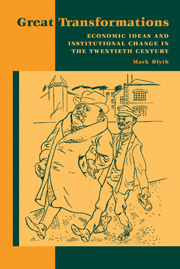2 - A Theory of Institutional Change
Published online by Cambridge University Press: 05 June 2012
Summary
Kathryn Sikkink noted that “it is a paradox that scholars, whose entire existence is centered on the production and understanding of ideas, should grant ideas so little significance for explaining political life.” The source of this paradox lies in the way contemporary political science has conceptualized the relationship among institutions, interests, and ideas. The purpose of this chapter is to reformulate these concepts and resolve this and other paradoxes in a theoretically productive way.
The first section of this chapter reviews existing ideational approaches in political science and argues that the current literature fails to take ideas seriously as both objects of inquiry and significant explanatory categories. This failure is principally due to the tendency of both the major schools of ideational analysis, historical institutionalism and rationalist institutionalism, to use ideas as “fillers” or auxiliary hypotheses to solve preexisting problems within their respective research programs. Given this tendency, neither school fully investigates ideas as explanatory factors in their own right. Further, by building a theory of ideas out of a prior theory of institutions, ideas become derivative of the mode of analysis in which they are operationalized. This creates a homology of ideas and institutions that precludes the development of a theory of ideas and institutional change that takes ideas seriously as explanatory categories.
This homology of ideas and institutions is not the only problem encountered in developing a better theory of institutional change.
- Type
- Chapter
- Information
- Great TransformationsEconomic Ideas and Institutional Change in the Twentieth Century, pp. 17 - 46Publisher: Cambridge University PressPrint publication year: 2002
- 3
- Cited by



